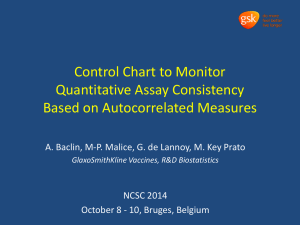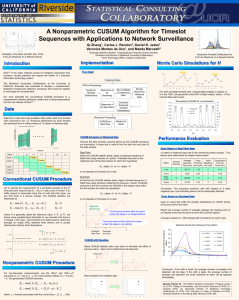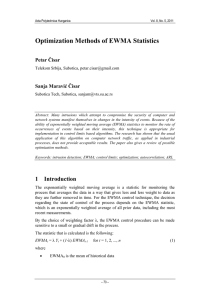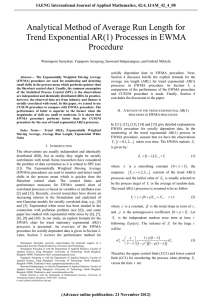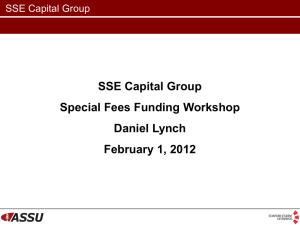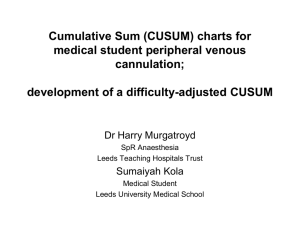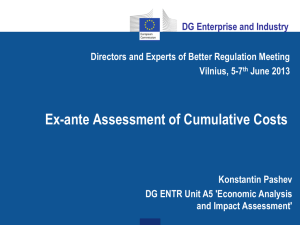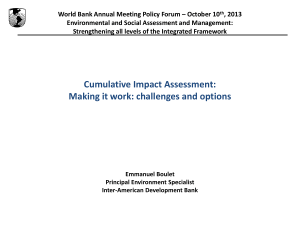Applying Control Charts for Change-Point Detection
advertisement
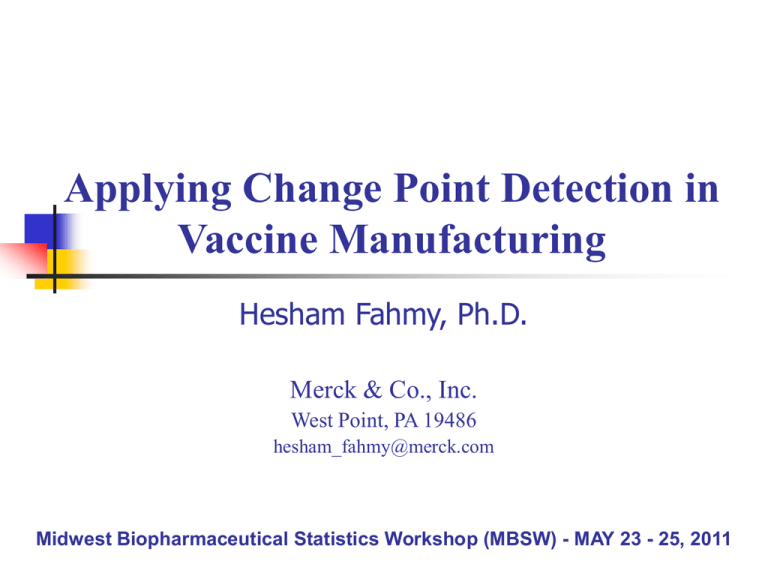
Applying Change Point Detection in Vaccine Manufacturing Hesham Fahmy, Ph.D. Merck & Co., Inc. West Point, PA 19486 hesham_fahmy@merck.com Midwest Biopharmaceutical Statistics Workshop (MBSW) - MAY 23 - 25, 2011 Outline Definitions Case studies Detection methods CUSUM and EWMA estimators CUSUM and EWMA SSE Conclusions 2 Methods of Detection Visual (Simple but Subjective) Raw data; run chart CUSUM chart EWMA chart Analytical (Complicated but Objective) Change-Point estimators; i.e. CUSUM, EWMA Mathematical Modeling; i.e. MLE, SSE 3 Types of Variation Common Causes – natural (random) variations that are part of a stable process Machine vibration Temperature, humidity, electrical current fluctuations Slight variation in raw materials Special Causes – unnatural (non-random) variations that are not part of a stable process Batch of defective raw material Faulty set-up Human error Incorrect recipe 4 Cumulative Sum Control Chart CUSUM: cumulative sum of deviations from average C t max 0, y t 0 K C t1 Ct accumulate d deviations above/belo w 0 A bit more difficult to set up More difficult to understand Very effective when subgroup size n=1 Very good for detecting small shifts Change-point detection capability Less sensitive to autocorrelation 5 Exponentially Weighted Moving Average EWMA: weighted average of all observations t -1 Et 1 - yt j 1 E0 j t j 0 A bit more difficult to set up Very good for detecting small shifts Change point detection capability Less sensitive to autocorrelation “EWMA gives more weight to more recent observations and less weight to old observations.” CUSUM 0 1 Shewhart 6 Process Shifts Step Linear Nonlinear Others 7 Process Model t in-control state out-of-control state Change point, "Unknown" 8 Change-Point Estimation Procedures CUSUM Change-Point Estimation Procedure (Page 1954) ˆCUSUM t : Ct 0, 0 Ci H i t 1,....T 1, CT H Ct accumulate d deviations above/belo w 0 EWMA Change-Point Estimation Procedure (Nishina 1992) ˆEWMA t : Et 0 , 0 Ei UCLi i t 1,...., T 1, ET UCLT 9 Process D ata 12 y Example: 11 10 9 8 1 Actual Change-Point= 20 2 3 4 5 6 7 8 9 10 11 12 13 14 15 16 17 18 19 20 21 22 23 24 25 26 27 28 29 30 t C t max 0, y t 0 K C t1 U pper CU SU M Chart 5 H 5 3 C+ K 0.5 4 2 1 0 1 2 3 4 5 6 7 8 9 10 11 12 13 14 15 16 17 18 19 20 21 22 23 24 25 26 27 28 29 30 t ˆCUSUM t : Ct 0, 0 Ci H i t 1,....T 1, CT H Most Recent Reintialization at t =22 10 Process D ata 12 Example: y 11 10 9 8 1 Actual Change-Point= 20 2 3 4 5 6 7 8 9 10 11 12 13 14 15 16 17 18 19 20 21 22 23 24 25 26 27 28 29 30 t Et yt 1 Et 1 0.2 E0 0 10 EW MA C hart 11.0 UCL=11 E LCL=9 10.5 10.0 9.5 1 2 3 4 5 6 7 8 9 10 11 12 13 14 15 16 17 18 19 20 21 22 23 24 25 26 27 28 29 30 t ˆEWMA t : Et 0 , 0 Ei UCLi i t 1,...., T 1, ET UCLT Most Recent time Et at t =19 11 450 425 400 375 350 325 300 275 250 225 200 175 150 125 100 75 50 25 Run Chart of Prodx Real Example R un C har t of Prodx 33.0 32.0 31.0 30.0 29.0 Sample 12 CUSUM vs. EWMA C USU M of Prodx 140 130 120 100 90 80 70 EW MA of Pro dx, Lamda=0.001 60 50 31.14 31.13 20 31.12 31.09 Avg=31.0870 31.08 31.07 Sample 425 375 325 275 225 175 31.06 125 375 350 325 300 31.10 75 Sample 275 250 225 200 175 150 125 100 75 50 -10 31.11 450 0 425 10 400 EWMA of Prodx 30 25 40 25 Cumulative Sum of Prodx 110 13 EW MA of Prodx, Lamda= 0.2 32.5 0.2 31.5 Avg=31.087 31.0 30.5 30.0 450 425 400 375 350 325 300 EW MA of Prodx, Lamda= 0.5 275 250 225 200 175 150 125 100 75 50 29.5 25 Sample 32.5 32.0 31.5 Avg=31.087 31.0 30.5 30.0 450 425 400 375 350 325 300 275 250 225 200 175 150 125 100 75 50 29.5 25 0.5 EWMA of Prodx EWMA of Prodx 32.0 Sample 14 Simulated Case Studies To test different methods' (control charts/analytical) capability for identifying change-points Case # 1: small shifts/drifts Case # 2: mirror image of case # 1 Case # 3: large shifts/drifts 15 Case #1 Chhar art off Y Y RRuunn C t o 44 33 22 Run Chart Chart ofof YY Run 11 00 -1 -1 -2 -2 -3 -3 -4 -4 -5 -5 -6 -6 00 25 25 50 50 75 75 100 100 125 125 Sample Sample 150 150 175 175 200 200 225 225 250 250 16 Case # 1 I ndividual Measur ement of Y 4 1 3 1 & 6: In-control process; N(0,1) : -ve linear trend; 0.1 sigma 3 : Step shift; N(-3,1) 4 : Step shift; N(-1.5,1) 5 : +ve linear trend; 0.1 sigma 3 4 5 6 2 1 0 -1 Y 2 2 -2 -3 -4 -5 -6 -7 0 25 50 75 100 125 150 175 200 225 250 Obs 17 CUSUM (V-Mask) C USU M of Y (Al pha=0.0027) Samples 40 to 60 100 3 Run Chart of Y 2 75 1 50 0 Cumulative Sum of Y -1 -2 60 58 56 54 52 50 48 46 44 42 40 -3 Sample 25 0 -25 Run Chart of Y -50 4 3 -75 2 1 Run Chart of Y -100 0 0 25 50 75 100 125 150 175 200 225 250 Sample -1 -2 Diagnostic Sequence Plot -3 -4 -5 -6 0 25 50 75 100 125 Sample 150 175 200 225 250 Detection Criterion: Slope Change 18 CUSUM; 0.01 C USU M of Y (Al pha=0.01) 100 Cumulative Sum of Y 75 0.0027 C USU M of Y (Al pha=0.0027) 100 75 50 25 0 -25 -50 Cumulative Sum of Y 50 -75 25 -100 0 0 -25 25 50 75 100 125 150 175 200 225 250 Sample -50 -75 -100 0 25 50 75 100 125 150 175 200 225 250 Exact Profile Sample 19 CUSUM – Target Adjusted CUSUM of Y - Target= 0 C USU M of Y - Targ et= 0 -100 Cumulative Sum of Y -150 Cumulative Sum of Y 0 -200 -250 -300 -100 50 75 100 125 150 175 200 Sample -200 C USU M of Y - Target= 0 50 Cumulative Sum of Y -300 0 0 25 50 75 100 125 150 175 200 225 250 Sample -50 -100 -150 0 25 50 75 Sample 100 125 150 20 EWMA; 0.5 EW MA of Y (Lamda=0. 5) Samples 40 to 60 2 3 1 1 0 0 -2 Sample 60 58 56 54 52 50 48 46 44 42 -3 EWMA of Y -1 40 Run Chart of Y 2 -1 Avg=-1.11 -2 -3 -4 -5 0 25 50 75 100 125 150 175 200 225 250 Sample Detection Criterion: Slope Change 21 EW MA of Y (Lamda=0.001) -1.02 -1.04 -1.06 EWMA of Y -1.08 -1.10 Avg=-1.1080 -1.12 -1.14 -1.16 EWMA; 0.001 -1.18 -1.20 0 25 50 75 100 125 150 175 200 225 250 Sample Same Profile C USU M of Y (Al pha=0.01) 100 Cumulative Sum of Y 75 50 25 0 CUSUM -25 -50 -75 -100 0 25 50 75 100 125 Sample 150 175 200 225 250 22 Case # 2 “Mirror Image” I ndividual Measur ement of Y 7 1 6 1 & 6: In-control process; N(0,1) 2 3 4 5 6 5 4 3 4 5 : +ve linear trend; 0.1 sigma : Step shift; N(3,1) : Step shift; N(1.5,1) : -ve linear trend; 0.1 sigma 3 2 Y 2 1 0 -1 -2 -3 -4 0 25 50 75 100 125 150 175 200 225 250 Sample 23 CUSUM Chart C USU M of Y Case # 2 Cumulative Sum of Y 100 0 C USU M of Y (Al pha=0.01) 0 100 25 50 75 100 125 150 175 200 225 250 Sample Cumulative Sum of Y 75 Mirror Image 50 25 0 -25 -50 Case # 1 -75 -100 0 25 50 75 100 125 Sample 150 175 200 225 250 24 CUSUM – Target Adjusted CUSUM of Y - Target= 0 350 300 Cumulative Sum of Y 250 200 150 100 50 0 0 25 50 75 100 125 150 175 200 225 250 Sample 25 EWMA Chart; 0.01 EW MA of Y-Lamda=0. 01 1.8 1.7 1.6 1.5 EWMA of Y 1.4 1.3 1.2 1.1 1.0 Avg=0.992 0.9 0.8 0.7 0.6 0.5 0 25 50 75 100 125 150 175 200 225 250 Sample 26 EWMA Chart; 0.2 EW MA of Y - Lamd a=0.2 4 3 EWMA of Y 2 1 Avg=0.99 0 EW MA of Y - Target= 0, Lamda= 0.2 4 -1 3 0 25 50 75 100 125 150 175 200 225 250 EWMA of Y Sample 2 1 0 µ0=0.00 -1 0 25 50 75 100 125 Sample 150 175 200 225 250 27 EWMA Chart; 0.5 EW MA of Y-Lamda=0.5 5 4 EWMA of Y 3 2 1 Avg=0.99 0 -1 -2 0 25 50 75 100 125 150 175 200 225 250 Sample 28 Case # 3 I ndividual Measurement of Y 1 & 6: In-control process; N(0,1) 17 2 : +ve linear trend; 0.5 sigma 13 3 : Step shift; N(12.5,1) 4 : Step shift; N(9.5,1) 6 5 4 3 2 1 15 11 Y 9 7 5 3 5 : -ve linear trend; 0.38 sigma 1 -1 -3 -5 0 25 50 75 100 125 150 175 200 225 250 Sample 29 CUSUM C USU M of Y 400 Cumulative Sum of Y 300 200 100 0 -100 -200 -300 0 25 50 75 100 125 150 175 200 225 250 Sample 30 CUSUM – Target Adjusted CUSUM of Y - Target=0 600 500 Cumulative Sum of Y 400 300 200 100 0 -100 -200 -300 CUSUM of Y - Target=0 1000 1400 1300 1200 1100 Cumulative Sum of Y Cumulative Sum of Y C USU M of Y - Target=0 -400 -500 -25 0 25 50 75 100 1000 900 800 700 600 125 Sample 500 400 300 0 50 75 100 125 150 175 200 Sample 0 25 50 75 100 125 150 175 200 225 250 Sample 31 EWMA; 0.5 EW MA of Y, Lamda=0.5 16 14 12 EWMA of Y 10 8 6 Avg=5.45 4 2 0 -2 0 25 50 75 100 125 150 175 200 225 250 Sample 32 EWMA; 0.2 EW MA of Y, Lamda= 0. 2 16 14 EWMA of Y 12 10 8 6 Avg=5.45 4 2 0 -2 0 25 50 75 100 125 150 175 200 225 250 Sample 33 EWMA; 0.1 EWMA of Y EW MA of Y, Lamda=0.1 15 14 13 12 11 10 9 8 7 6 5 4 3 2 1 0 -1 -2 Avg=5.45 0 25 50 75 100 125 150 175 200 225 250 Sample 34 Detection by SSE Pick a window of about 30 points including the “investigated point” Fit a two-phase regression using all possible change-points & calculate the SSE Plot possible change-points vs. their SSEs 35 60 to 90 W i ndow 35 to 65 Wi ndow 3 6 32 44 31 2 5 30 29 4 Y 26 SSE 0 38 3 27 Y 40 28 36 2 25 90% CI -1 34 24 1 32 23 -2 0 22 21 -3 30 28 -1 20 55 30 35 40 45 50 55 60 65 Examples from Case # 2 70 Obs Left Scale: Right Scale: Y 65 75 80 85 90 95 Obs Left Scale: Y Right Scale: SSE Overlay Pl ot 5 4 15 4 3 14 3 2 13 1 12 1 0 11 0 -1 10 -1 105 110 115 120 125 130 135 140 145 Y 16 SSE 5 105 70 SSE 110 to 140 Wi ndow Y 60 2 110 115 120 125 130 135 140 145 Obs Obs Left Scale: Right Scale: Y SSE 36 SSE 1 42 35 to 65 W i ndow 60 to 90 W i ndow 10 70 17.5 7.5 60 15 5 50 12.5 2.5 40 0 30 7.5 -2.5 20 5 -5 10 2.5 100 90 70 10 60 SSE Y SSE Y 80 50 40 35 40 45 50 55 60 65 70 20 55 60 65 70 Obs Left Scale: Y Right Scale: Left Scale: Examples from Case # 3 SSE 80 85 90 95 Y Right Scale: SSE 160 to 190 Wi ndow 110 to 140 Wi ndow 15 14 11 60 10 55 9 50 25 13 45 11 Y 20 SSE 8 12 Y 75 Obs 40 7 35 6 10 15 9 8 7 10 105 110 115 120 125 130 135 140 145 30 5 25 4 20 3 15 155 160 165 Right Scale: Y SSE 175 180 185 190 195 Obs Obs Left Scale: 170 Left Scale: Right Scale: Y SSE 37 SSE 30 30 Conclusions Change-point problem is general and can be applied in many applications such as 4 parameter logistic regression and degradation curves. Another application in manufacturing processes includes detection of the change-point for process variance. It is preferred to combine both analytical and visual techniques; in addition to process expertise; to get accurate results. 38 References • Fahmy, H.M. and Elsayed, E.A., Drift Time Detection and Adjustment Procedures for Processes Subject to Linear Trend. Int. J. Prod. Research, 2006, 3257–3278. • Montgomery, D. C., Int. to Stat. Quality Control, 1997, (John Wiley: NY). • Nishina, K., A comparison of control charts from the viewpoint of change-point estimation. Qual. Reliabil. Eng. Int., 1992, 8, 537–541. • Pignatiello, J.J. Jr. and Samuel, T.R., Estimation of the change point of a normal process mean in SPC applications. J. Qual. Tech., 2001, 33, 82–95. • Samuel, T.R., Pignatiello Jr., J.J. and Calvin, J.A., Identifying the time of a step change with X control charts. Qual. Eng., 1998, 10, 521– 39 527. Acknowledgements Lori Pfahler Julia O’Neill Jim Lucas 40
